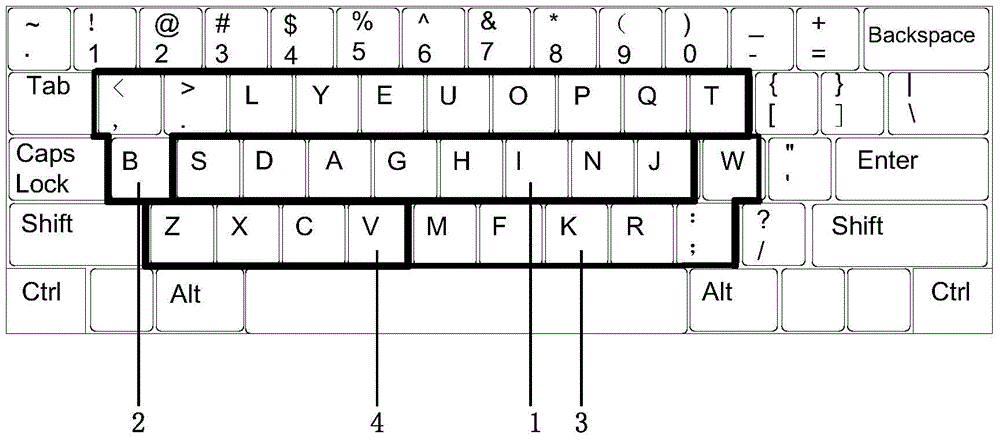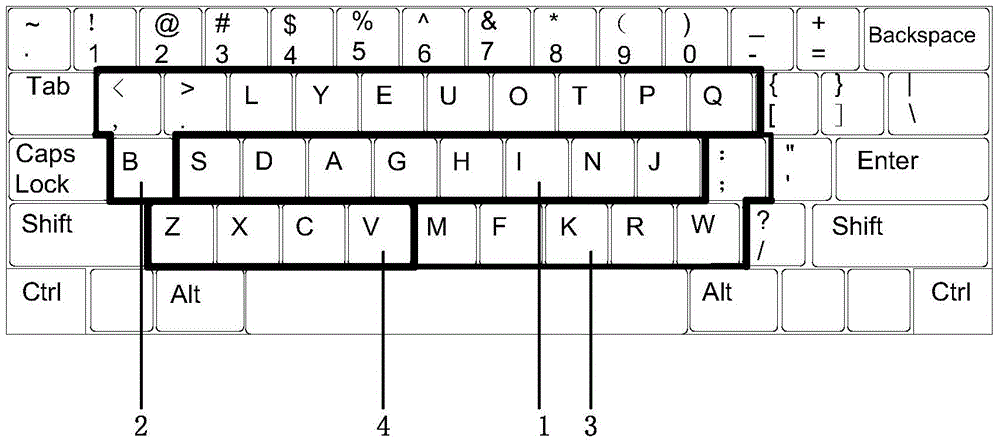a new type of keyboard
A keyboard, a new type of technology, applied in the direction of user/computer interaction input/output, etc., can solve the problems of inconvenient portability, slowing down computer work efficiency, etc., to reduce one-handed tapping, optimize the position of punctuation marks, and optimize key positions Effect
- Summary
- Abstract
- Description
- Claims
- Application Information
AI Technical Summary
Problems solved by technology
Method used
Image
Examples
Embodiment 2
[0052] See figure 2 As shown, it is a schematic structural diagram of Embodiment 2 of the present invention.
[0053] The second embodiment is similar to the first embodiment, except that:
[0054] The first input area 1 is in sequence from the second key from the left of the third row to the tenth key from the left of the third row: S key, D key, A key, G key, H key, I key, N key, J key key;
[0055] In the second input area 2, the sequence from the second key from the left of the second row to the eleventh key from the left of the second row is: (greater than sign) key, L key, Y key, E key key, U key, O key, P key, Q key, T key, the first key from the left in the third row is the B key;
[0056] The third input area 3 is sequentially from the sixth key from the left of the fourth row of the keyboard to the tenth key from the left of the fourth row of the keyboard: M key, F key, K key, R key, ": (colon)" key, The twelfth key from the left in the third row is the W key; ...
Embodiment 3
[0060] See image 3 As shown, it is a schematic structural diagram of Embodiment 3 of the present invention.
[0061] The third embodiment is similar to the first embodiment, except that:
[0062] The first input area 1 is in sequence from the second key from the left of the third row to the tenth key from the left of the third row: S key, D key, A key, G key, H key, I key, N key, J key key;
[0063] In the second input area 2, the sequence from the second key from the left of the second row to the eleventh key from the left of the second row is: (greater than sign) key, L key, Y key, E key key, U key, O key, T key, P key, Q key, the first key from the left in the third row is the B key;
[0064] The third input area 3 is sequentially from the sixth key from the left of the fourth row of the keyboard to the tenth key from the left of the fourth row of the keyboard: M key, F key, K key, R key, W key, and the third row from the left The twelfth key is the ": (colon)" key; ...
PUM
 Login to View More
Login to View More Abstract
Description
Claims
Application Information
 Login to View More
Login to View More - R&D
- Intellectual Property
- Life Sciences
- Materials
- Tech Scout
- Unparalleled Data Quality
- Higher Quality Content
- 60% Fewer Hallucinations
Browse by: Latest US Patents, China's latest patents, Technical Efficacy Thesaurus, Application Domain, Technology Topic, Popular Technical Reports.
© 2025 PatSnap. All rights reserved.Legal|Privacy policy|Modern Slavery Act Transparency Statement|Sitemap|About US| Contact US: help@patsnap.com



